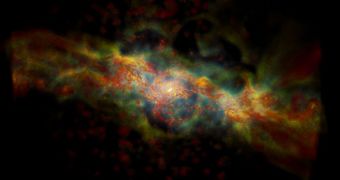For many years, the process of stellar formation has remained shrouded in mystery. But over the past few years, several studies have shed more light on these events, and also on their influences on their surroundings.
Instrumental in these studies was analyzing so-called fossil galaxies, which feature properties that experts simply did not expect to find at this stage of the Universe's development.
These structures are affected with what astronomers call cosmic turbulences, which are essentially interferences in the galaxy that may shed more light on how stars were form.
For the purpose of a new study into this issue, researchers selected a series of such cosmic structures from around the Universe for further investigations.
These were all relatively modern galaxies, that researchers believe resemble the most primordial galaxies. “They're living fossils of space – galaxies we just didn't expect to find in today's world,” says Andrew Green.
He is the coauthor of the new investigation, and holds an appointment as an astronomer at the Swinburne University in Australia. Details of the new work appear in the October 7 issue of Nature.
The expert and his group think that the new investigation may shed even more light on the mystery surrounding the process of stellar formation. Space reports.
“The most exciting thing about these findings to me is how they might tell us something about how stars form,” Green explains.
“Despite the fact that we live in a galaxy, the Milky Way, and we live next to a star, our sun, we still have a very poor idea of how galaxies form and evolve and how stars form from primordial gas,” he adds.
“Now we think we might have found a link between star formation and this galactic turbulence,” the investigator argues. He explains that galactic wind speeds were five times more variable in the early days of the Universe than they are now.
But the new work determined that galaxies with similar wind speed variability exist to this day. The research team found about 11 such structures, spread out 1 billion light-years away from Earth.
One of the main conclusions in the study was that matter falling into these galaxies, such as for example the one accumulated while cannibalizing dwarf galaxies, cannot account for the turbulences.
But the rates at which stars were formed in that particular galaxy were found to have a direct link to wind speed variability.
In other words, it would appear that the energy young blue stars release as they form is the main engine behind galactic turbulences. The study suggests that this was the case in the early days of the Universe as well.
“It's entirely possible that all spiral galaxies, including the Milky Way, went through a stage in the past when they had high star formation rates and associated high turbulence,” Green concludes.

 14 DAY TRIAL //
14 DAY TRIAL //